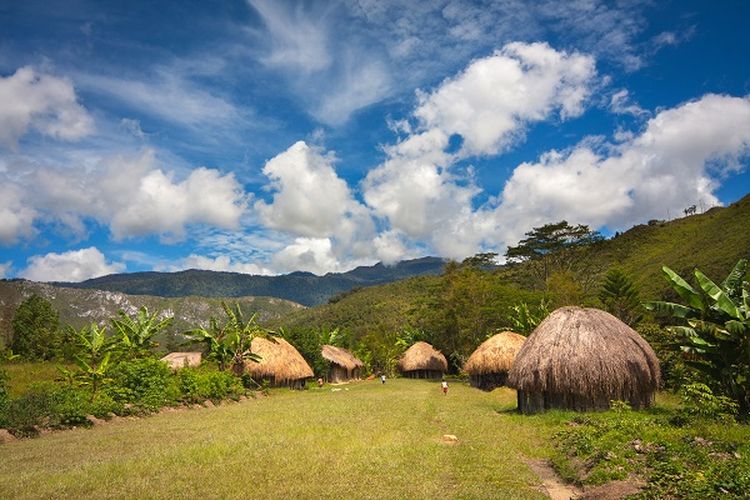Indonesia isn’t just famous for its natural wonders and delicious cuisine — it’s also home to one of the richest architectural heritages in the world. With over 17,000 islands and more than 1,300 ethnic groups, Indonesia offers a fascinating variety of ethnic traditional houses, each reflecting the unique culture, beliefs, and environment of the people who built them.
From the dramatic sweeping roofs of Toraja to the harmonious stilt homes in Papua, these traditional houses — known locally as rumah adat — are more than just places to live. They’re expressions of identity, local wisdom, and spiritual connection to land and ancestry.
Let’s take a tour through some of Indonesia’s most iconic and unique ethnic houses:
1. Tongkonan – Toraja, South Sulawesi

The Tongkonan is one of the most visually striking traditional houses in Indonesia. Shaped like an upward-curving boat, its towering saddleback roof is impossible to miss. Built on stilts and richly decorated with buffalo horn motifs and intricate wood carvings, the Tongkonan is a symbol of status and family lineage among the Torajan people. Fun Fact: The more buffalo horns stacked at the front of the house, the higher the family's status.
2. Rumah Gadang – Minangkabau, West Sumatra

With its dramatic, curved roofs that resemble buffalo horns, the Rumah Gadang is the traditional house of the Minangkabau people — the world’s largest matrilineal society. These longhouses are not just homes but communal spaces where extended families live together under the leadership of women. Each curve of the roof is deeply symbolic, representing harmony with nature, balance, and ancestral roots.
3. Rumah Honai – Dani Tribe, Papua

Deep in the central highlands of Papua lies the Honai, a small, round, thatched hut made of wood and straw. Though simple in appearance, the Honai is ingeniously warm — designed to trap heat in the cold mountainous region. These huts are often gender-specific: separate Honai are used for men, women, and livestock. In the Dani culture, fire inside a Honai is sacred — it provides warmth and fosters community bonds.
4. Rumah Baduy – Banten, West Java

Built entirely from natural materials like bamboo, palm fiber, and wood, the Rumah Baduy reflects the minimalist and nature-bound lifestyle of the Baduy tribe. These homes are constructed without nails or cement and follow strict spiritual guidelines that align with the tribe’s ancestral customs (pikukuh). Sustainability isn’t a trend here — it’s been a way of life for centuries.
5. Rumah Batak Toba – North Sumatra

The Batak Toba house, or Jabu, features a pointed roof like a reversed boat and stands on wooden stilts. The space beneath the house is often used to shelter livestock. Its massive roof is supported without nails — only interlocked wooden beams — and the entire structure is built with symbolic proportions and protective carvings. Traditional Batak houses often have mystical symbols to ward off evil spirits.
6. Rumah Sasak – Lombok, West Nusa Tenggara

The Sasak people of Lombok build their houses from bamboo, dried grass, and even cow dung — not as waste, but as a natural sealant for the floor! These humble homes are clustered in traditional villages like Sade and remain largely untouched by modern architecture. Visiting a Sasak village is like stepping back in time — a living museum of heritage.
Cultural Wisdom in Architecture
Each rumah adat isn’t just designed for looks — it responds directly to the environment, climate, and lifestyle of its people. Whether it’s elevated floors to protect from floods, wide communal halls for ceremonies, or layered roofs for ventilation, these homes are built with deep ecological and cultural knowledge.
They also serve a spiritual function — many are believed to be sacred spaces where ancestors reside, and every element, from shape to direction, is chosen with ritual significance.
Preserving the Past, Inspiring the Future
Sadly, many traditional houses are now at risk due to modernization, migration, and a loss of cultural knowledge. However, efforts are growing to preserve and revive them — not just as tourist attractions, but as living, breathing symbols of identity and pride.
Architects and designers are now looking to rumah adat for inspiration in creating sustainable, climate-adaptive buildings that respect both people and planet.
More Than Just a House
Indonesia’s ethnic houses are not just buildings. They’re stories. They are living expressions of culture, community, and connection to nature — built not with blueprints, but with heart, memory, and wisdom passed down through generations. If you ever get a chance to visit one, step inside with respect — and prepare to be humbled by what a house can truly mean.








